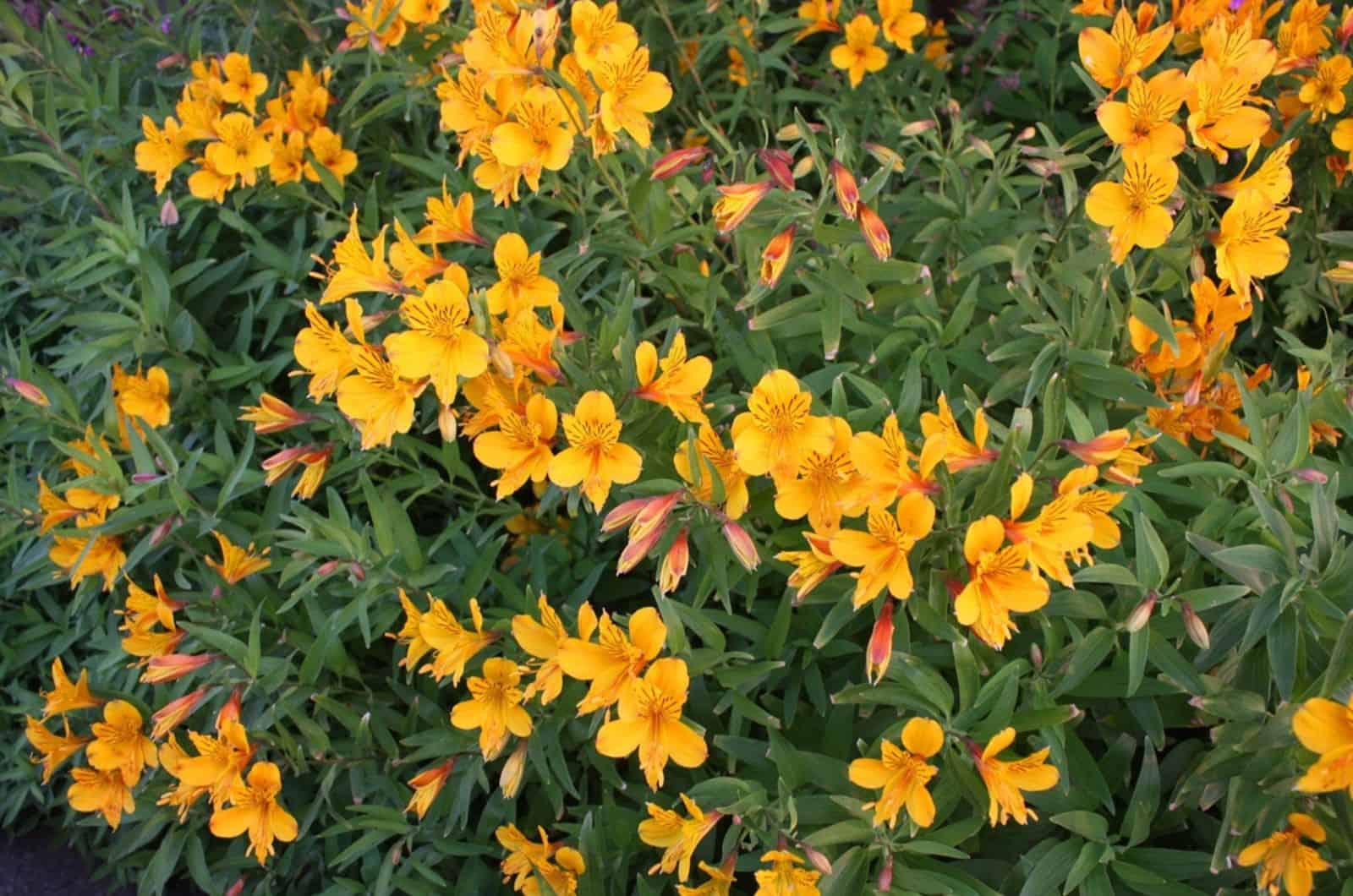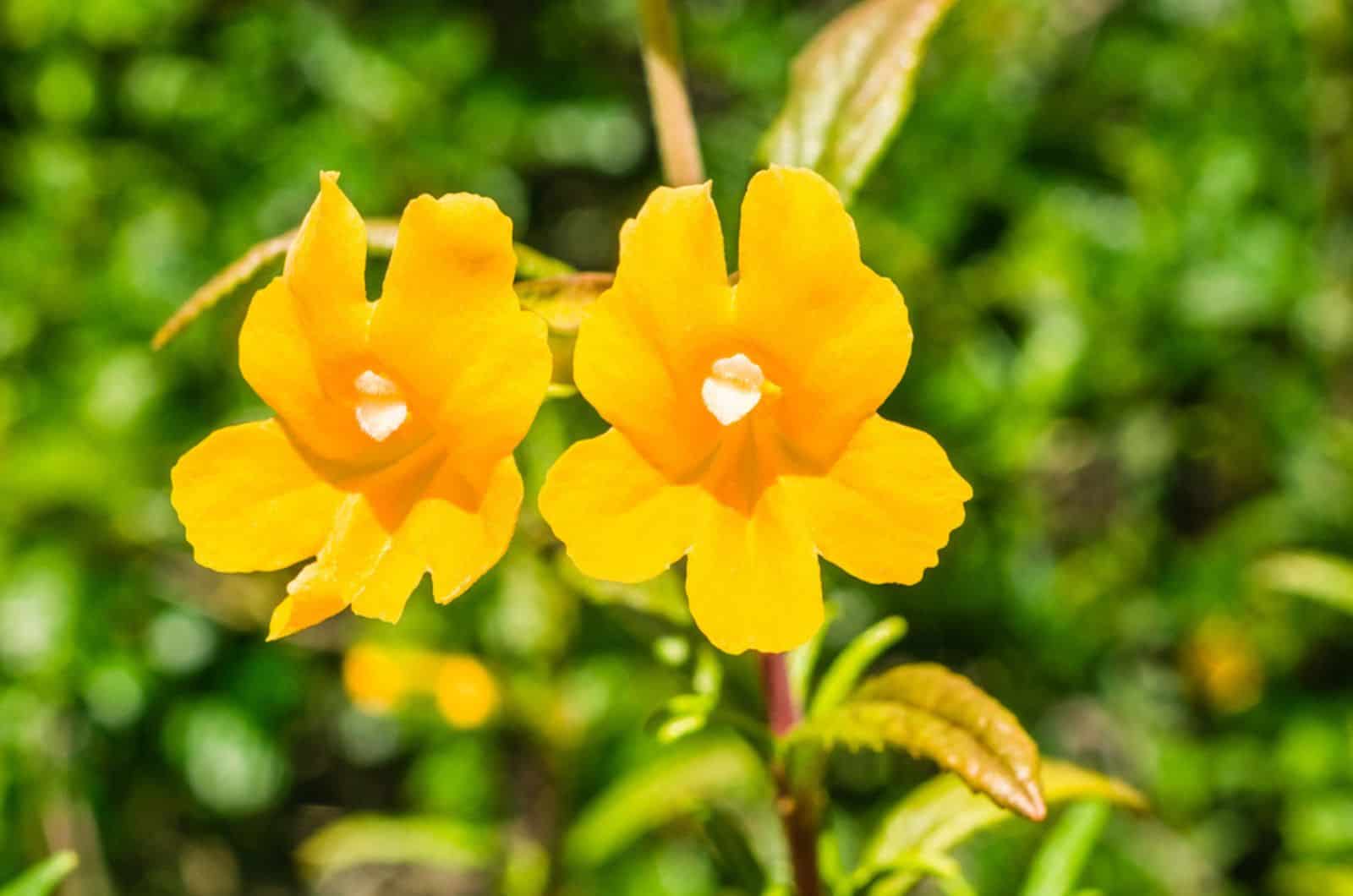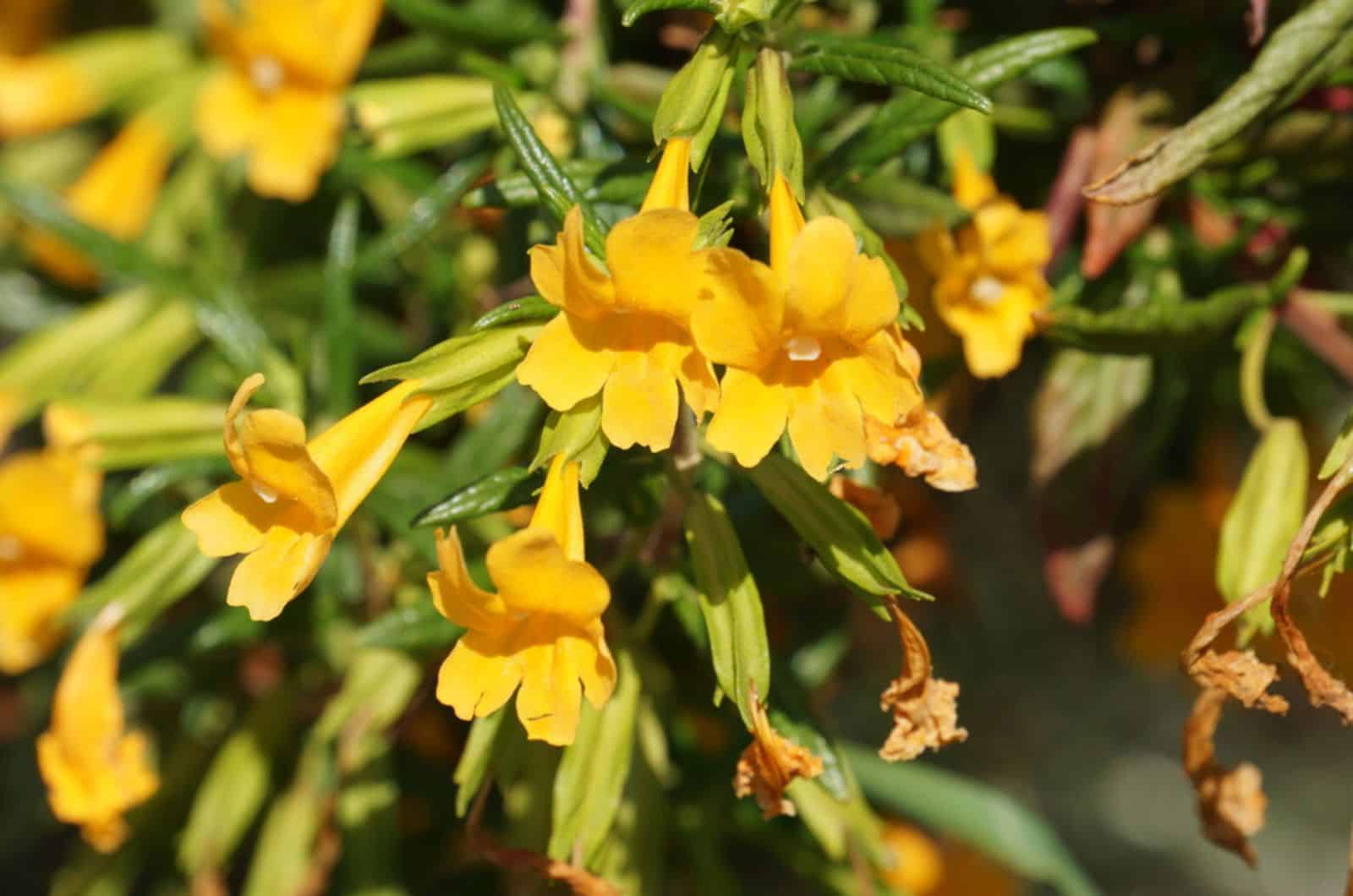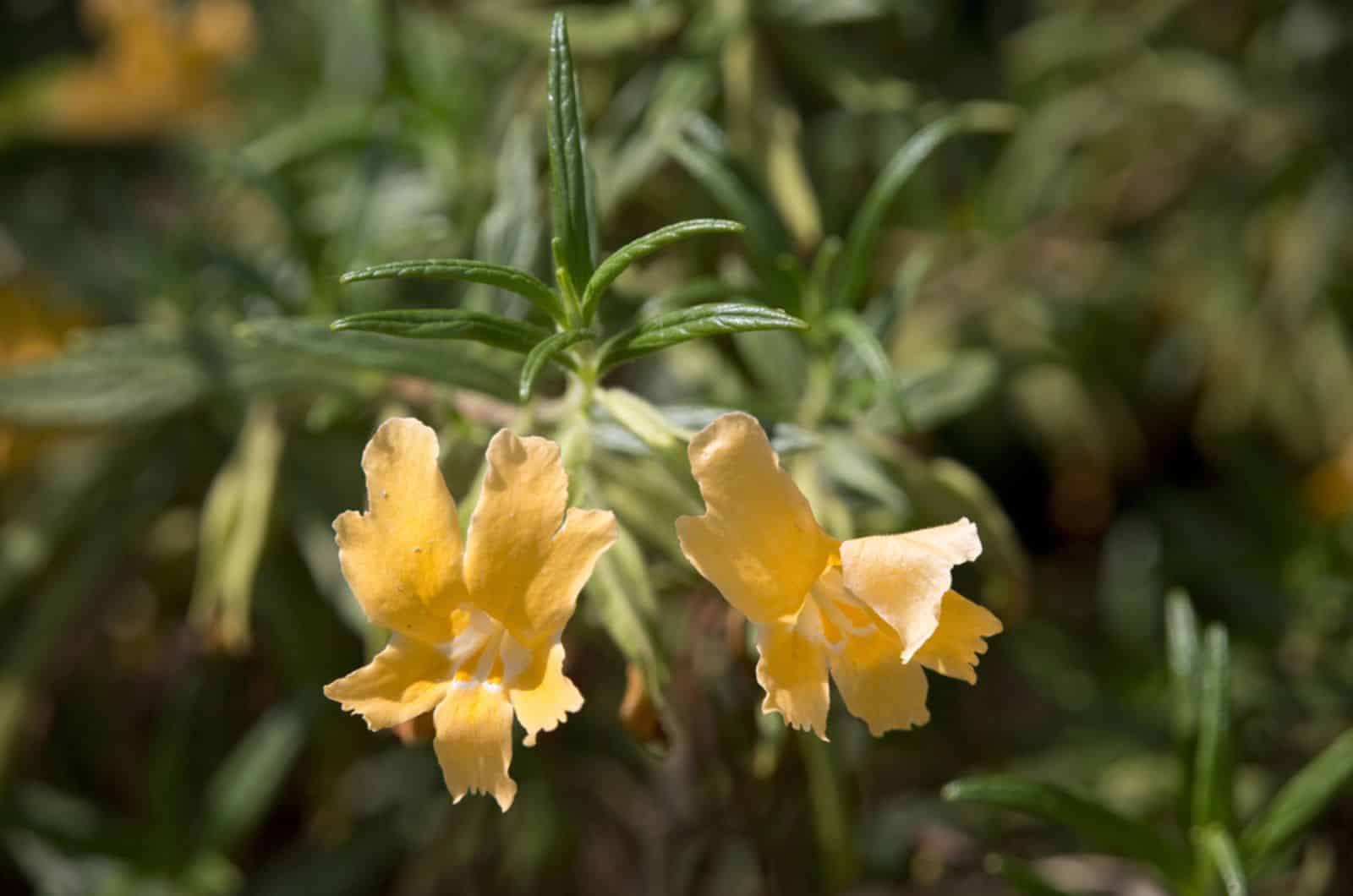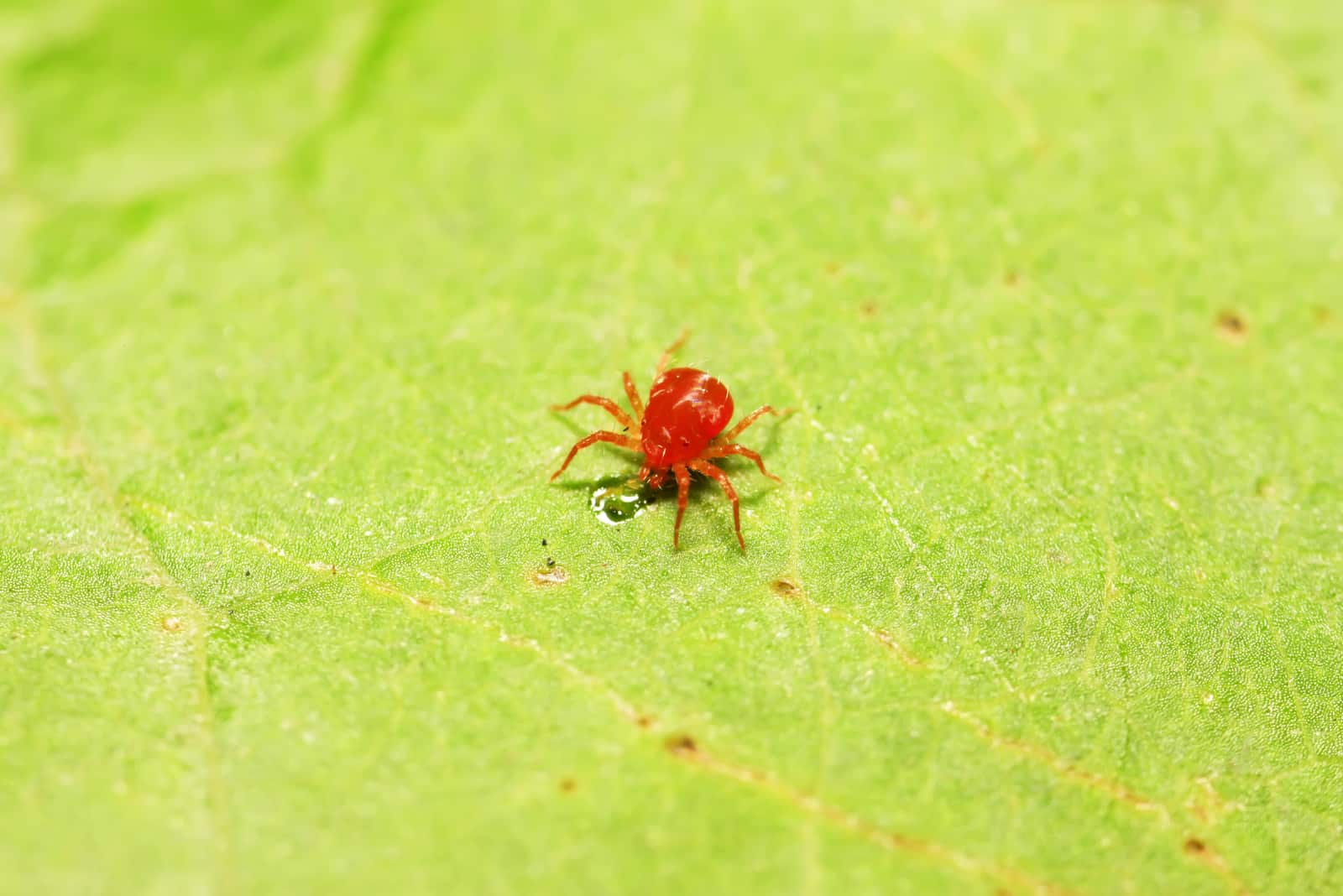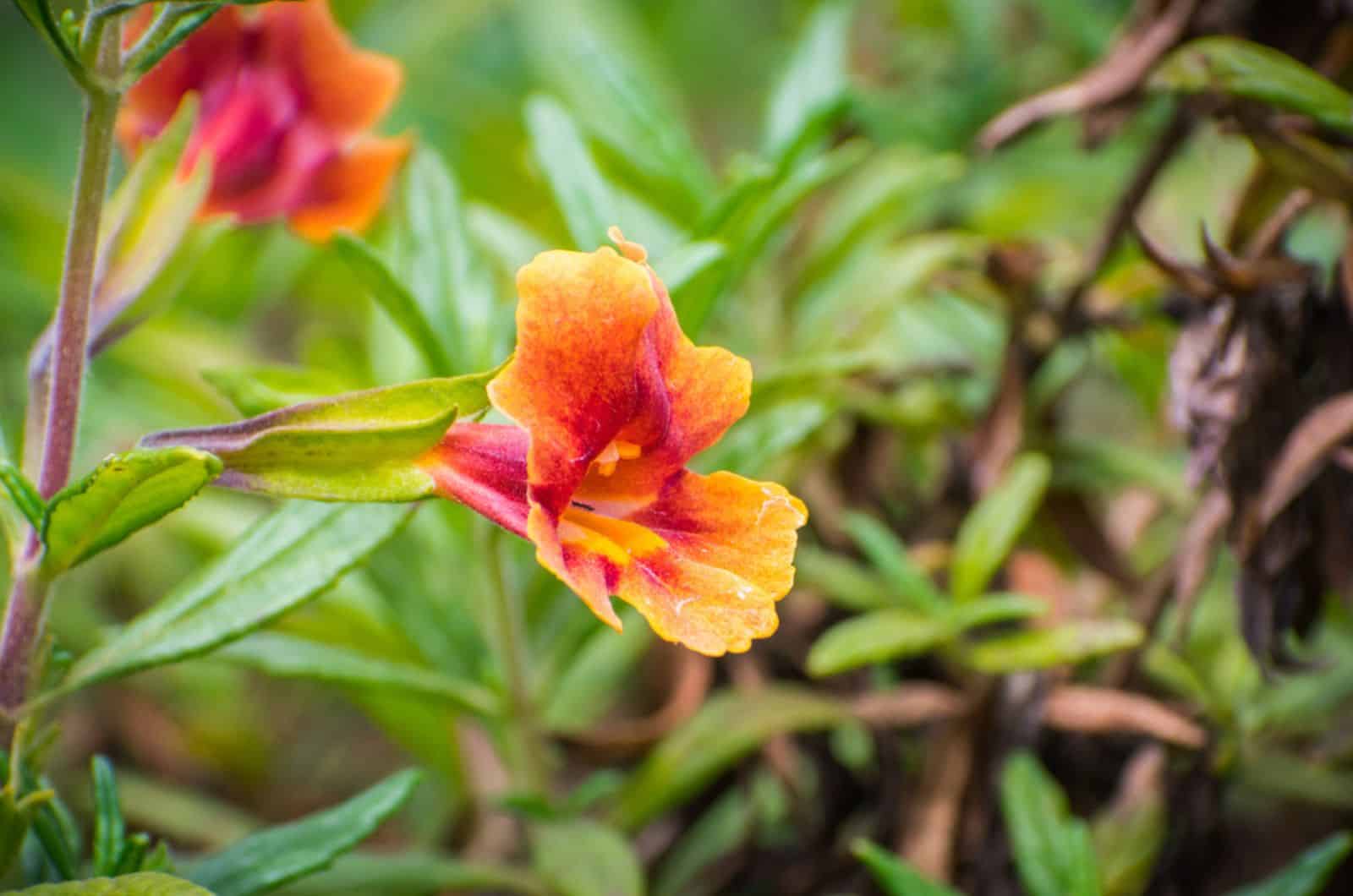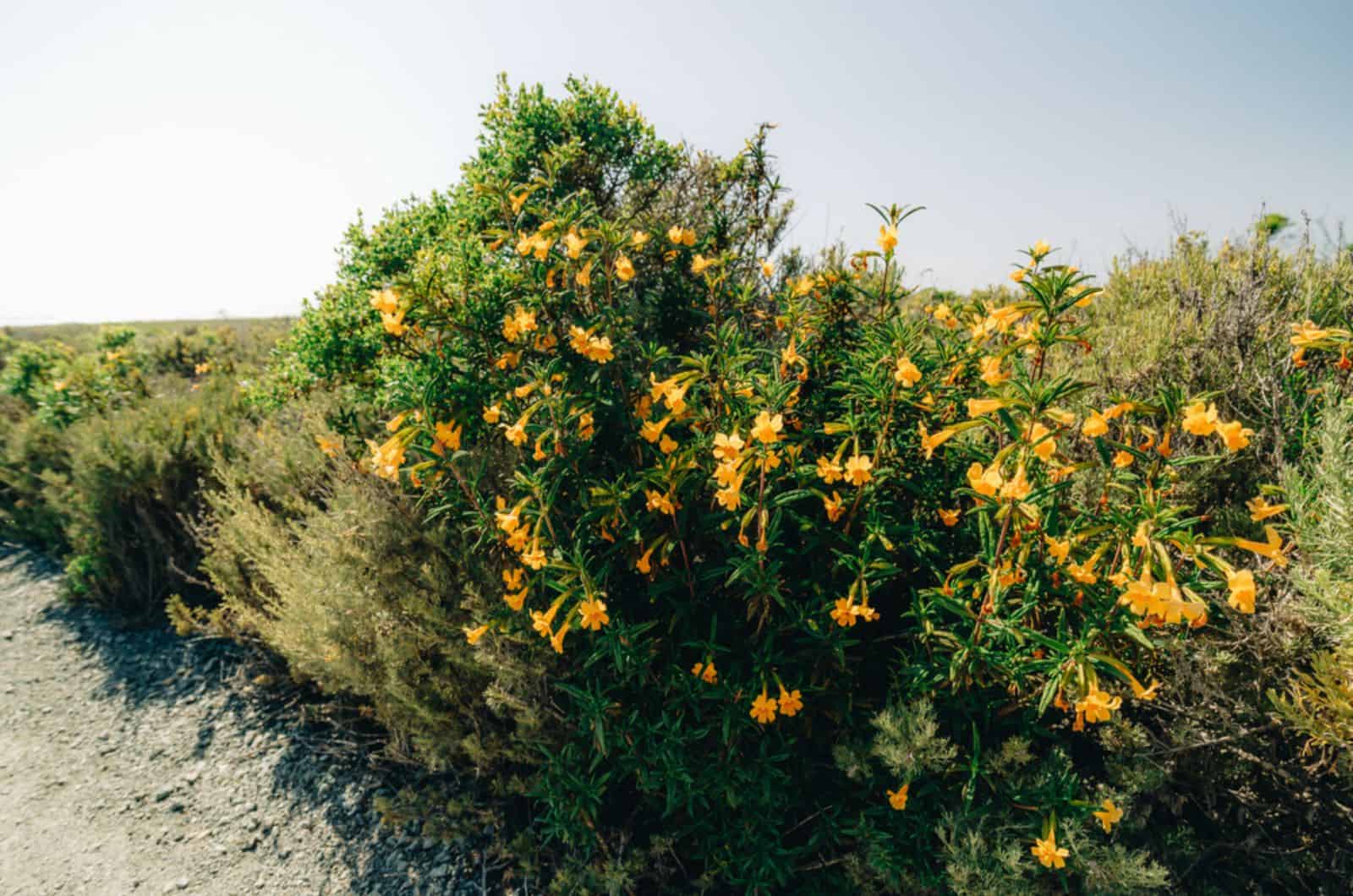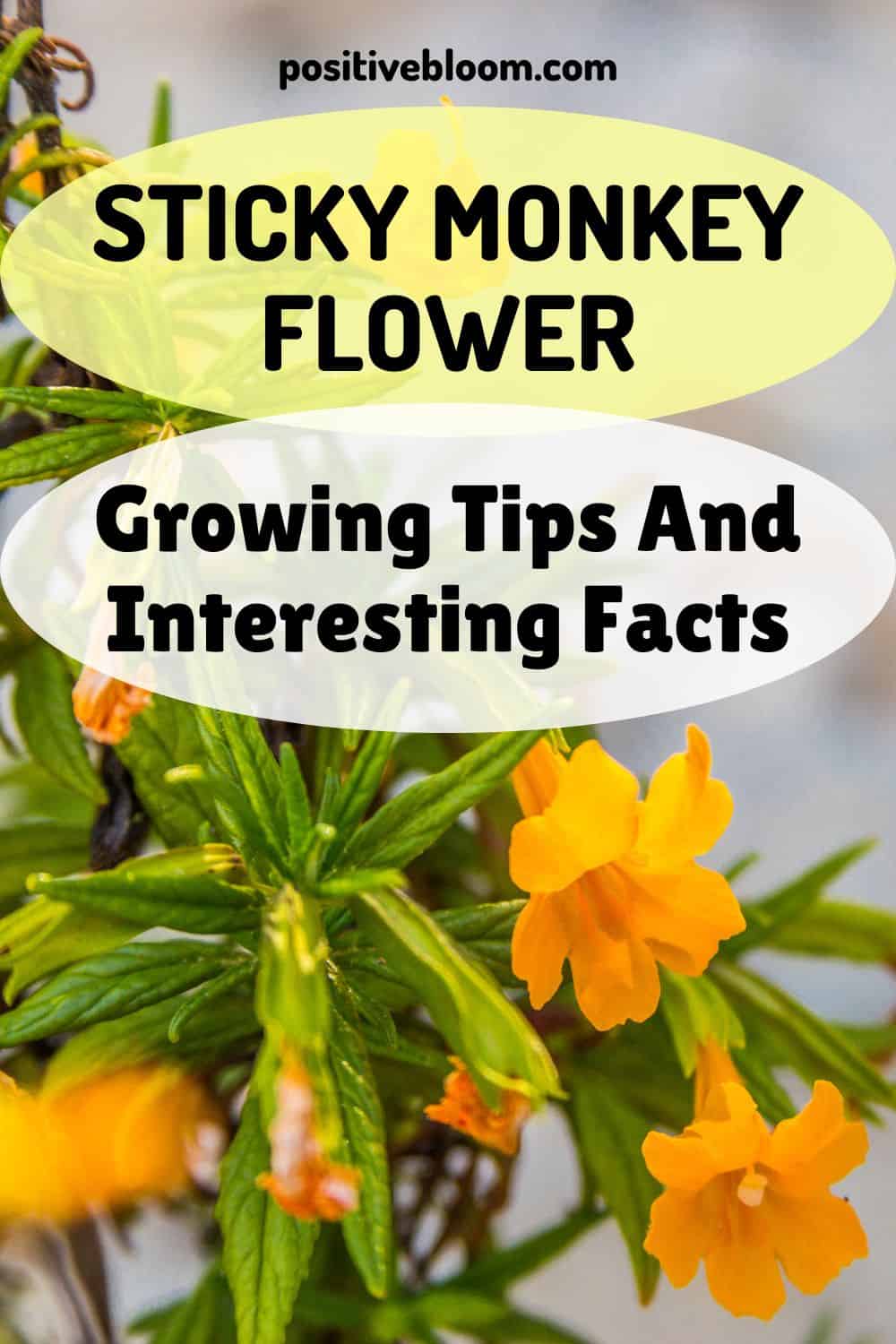Have you ever cruised through California and happened upon a yellow or orange shrub you simply had to have in your garden, but didn’t know what it was and how to grow it?
Well, it is highly likely that you have fallen in love with the sticky monkey flower!
We’ll discuss the most important questions you might have about this California native plant, such as its basic requirements, propagation options, common pests and diseases, and some interesting facts.
Before we get to all that, let’s learn some general specifics about this unique flower:
[table id=322 /]
Sticky Monkey Flower Care Guide
The sticky monkey, or bush monkey flower, is an excellent plant if you want to introduce some color into your front yard or indoor garden.
It doesn’t demand too much of your time, but you should still monitor it and tend to its needs, just like you would any other plant.
In this article, you will learn about the basic needs of this plant and understand where to plant it, when to water it, and how to take care of it.
Let’s begin!
Light Requirements
The orange bush monkeyflower has adapted to full sun conditions, but can thrive and bloom equally well in part shade.
In fact, some shade might even be good for this plant if it’s growing in a particularly hot climate.
You can plant this flower in an eastern or southern corner of your yard as the morning or late afternoon sun isn’t as harsh, so it won’t burn your monkey plant’s beautiful foliage.
If you live in a colder region or you simply want to grow this plant indoors, just follow the same rule and place the pot near an east or south-facing window.
West-facing windows usually get stronger light, but you can put this plant a few feet away from the window, and it will thrive and avoid sunburn.
Finally, if your flat faces north, you can always use artificial lights to keep your plant healthy.
However, artificial lights can burn plants due to the heat they emit, so you should always keep your plant at least 1 foot away from them if you use LED lights or further if you go for incandescent lighting.
Water And Humidity
One of the things that makes this plant so easy to maintain is the fact that it only requires the same amount of water as succulents.
Once the plant is established, it is fairly drought-tolerant and doesn’t need supplemental watering unless the winters and springs are unusually warm and dry.
However, younger bushy monkey flowers, and those grown in containers, require more moisture to develop a strong root system.
If you don’t know how often you should irrigate this plant, you can always check the soil moisture. Either stick your finger into the top 2-3 inches of the soil or use a moisture meter and if the growing medium is still moist, you don’t have to water it.
Another amazing thing about this monkey flower is that it goes dormant during the hot summer and stays like that until the rainy season starts.
Humidity
This plant is native to regions in southwestern Oregon to Baja California in Mexico, which means it can tolerate various weather conditions.
This sticky flower can tolerate drier climates, but you should still ensure that the relative humidity is at least 40%.
Temperature
This plant thrives in USDA zones 8-11, so you should take it indoors if your region experiences temperatures lower than 10-15°F.
However, this native shrub thrives in temperatures between 70-75°F, so if you don’t live in warm climates, you should consider growing it indoors.
Also, avoid keeping it in locations that experience sudden temperature swings, such as near heaters, AC vents, and drafty windows.
Soil And Fertilizer
The bush monkey flower is one of those plant types that can thrive in a variety of soils, just as long as they are well-drained.
For instance, it can grow in rocky, sandy mediums (or even serpentine), clay substrates, and soils enriched with loam-based compost.
However, you should provide excellent drainage for this plant so that it doesn’t suffer from overwatering or root rot.
Thankfully, raised garden beds and pots with holes in the bottom minimize the risk of water-clogging, so you won’t have to worry about rotting roots.
However, you should still amend the soil with some perlite, pumice, orchid bark, or sand if it’s really heavy.
Another thing I like about this plant is that it can absorb nutrients in mildly alkaline, neutral, and slightly acidic soils, so there’s no need to buy acidifying liquids or lime.
Fertilizer
This plant doesn’t need fertilizer to thrive, so you can simply add some compost or organic fertilizer (if you really want) at the beginning of its growing season.
If you repot this plant once a year into fresh soil, you won’t have to add any additional nutrients as the new growing medium is already enriched with all the minerals the plant needs.
However, sticky monkey plants planted in the ground need a steady income of nutrients, which is why adding compost or cow manure once a year is necessary.
You can also add an all-purpose, slow-release fertilizer after the plant wakes up from dormancy.
Repotting And Transplanting
These plants don’t respond well to repotting and transplanting, so don’t move them unless it’s absolutely necessary.
Of course, if you have propagated your own bush monkey flower at home, you will have to move it to a larger container at some point.
In that case, there are a couple of things you should pay attention to in order to give your plant the best chance for success.
First, water your monkey flower thoroughly a couple of days before repotting or transplanting it. When plants are moved from one soil to another, they usually get stressed out and cannot absorb water and nutrients from the new habitat.
Therefore, keeping the plant hydrated can help alleviate the effects of transplant shock.
Another thing that can help your plant survive the move is transplanting it on a cloudy day because the sun isn’t too harsh and won’t burn it. It won’t increase the transpiration or evaporation rate either.
Finally, I know that planting any flower or veggie in the ground isn’t easy, so I recommend these excellent garden kneelers for older gardeners, which are not age-exclusive, so we can all use them to make transplanting our plants a lot easier!
Pruning
Pruning the sticky monkey flower is necessary, and it will help you control the plant’s shape and keep it healthy. If you don’t cut your monkey plants at least once a year, they can become leggy, and their branches might even break under all that weight.
If your plant is overall healthy, and you just want to shape it a bit, there are a couple of pruning hacks that can help you do so faster and more efficiently.
The first thing you need to do is get a good pair of secateurs, such as pruners for arthritic hands, as they have comfortable handles and special mechanisms that don’t require too much strength.
Once you get to pruning, ensure that you trim the stem below the bottommost spent blossom, but don’t remove the entire stem because the plant still needs its leaves in order to photosynthesize.
If you remove all the plant’s foliage, it might not be able to regrow. Check out this great video full of pruning tips that will keep your plant neat and healthy:
How To The Propagate Sticky Monkey Flower
Luckily for us, there are a couple of ways to multiply this beautiful shrub. However, this section will discuss the two most common methods: propagating the bush monkey flower from seeds and cuttings.
How To Grow A Sticky Monkey Flower From Seed
The flowers of this plant will produce seeds once they’re done blooming, and you can use these seeds to grow more monkey plants. They need to be chilled before you plant them, or their husk might not break, which means they won’t germinate.
Put the seeds in a plastic bag and leave them in the fridge for a month or so. Once spring approaches, you can take the seeds out of the refrigerator and plant them into a seed-starting mix.
Keep the medium consistently moist and cover it with a plastic sheet to increase humidity.
Place the nursery pot in bright light, and once the seeds have germinated and grown 3-4 leaves, you can divide and plant them into separate pots.
Propagating The Bush Monkey Flower From Cuttings
Multiplying this plant from cuttings is fairly easy. All you’ve got to do is take a healthy cutting that’s 4-6 inches long. Remove the bottommost foliage, as it can rot and contaminate the growing medium.
Dip the cutting into a rooting hormone and plant it in a moist, well-draining growing substrate or seed-starting mix.
It will take approximately two months for the cutting to develop new roots, and you’ll know the propagation has been a success when you notice new growth.
If you can’t quite tell whether the cutting has grown, you can always slightly tug it, and if you feel some resistance, you’ll know the root system has developed.
Give your plant a couple more months, and then repot it into a larger pot.
You should keep your monkey flower cutting in a well-lit spot at all times, though it would be best to avoid any harsh midday sun because it would damage the delicate leaves.
Pests And Diseases
The sticky monkey flower is fairly pest-resistant and is on many growers’ plant lists!
The plant has developed a defense mechanism that keeps pests at bay. Its leaves are composed of resin (which is probably why it’s called “sticky”), which makes it less likely to be attacked by herbivores.
However, butterfly larvae of the species Euphydryas chalcedona (variable checkerspot) and Junonia coenia (common buckeye butterfly) aren’t perturbed by this, and you may find these nuisances nibbling on your plant’s foliage in the spring!
Fortunately, the resin production and nutrient levels are high during this time, and they inhibit the growth of larvae. Eventually, these little bugs will stop feeding on your plant completely once the summer arrives and the plant starts blooming.
We cannot even say that these are real pests because the larvae soon turn into butterflies that take part in the pollination process!
Diseases
This plant is resistant to many diseases, but still isn’t immune to root rot. This fungal infection is caused by overwatering, so is easily prevented.
All you’ve got to do is irrigate your plants once the topsoil is dry (or not water them at all if the winters and springs are rainy enough), and that’s it!
However, if you notice that this California native wildflower starts drooping, slows down its growth, or stops growing entirely, and its leaves start turning yellow and red, you should check the plant’s roots immediately.
Remove the diseased roots (dark or brown and soft), and treat the rest of them with a fungicide.
Repot the plant into a new container filled with fresh soil, and reduce irrigation. This disease is severe and can kill your plant if you don’t detect it on time.
More About The Bush Monkey Flower
There are so many more interesting things about the sticky monkey plant still to learn!
For instance, there’s been a lot of confusion about its name. Botanists have moved it from one genus to another and from one family to another, etc.
We’ll discuss all this and more in the paragraphs below.
Origin And Backgrounds
According to the Jepson eFlora taxon page, the sticky monkey flower belongs to the family Phrymaceae, also known as lopseed, but that hasn’t always been the case.
This plant was first classified as a member of the Scrophulariaceae, or snapdragon, family.
And that’s not where the confusion ends!
The bush monkey flower first belonged to the genus Mimulus, but the name was probably changed because Mimulus plants need plenty of water, while this particular monkey flower does not, just like the plants that belong to the Diplacus genus.
And before I forget, Diplacus aurantiacus, Mimulus aurantiacus, or whatever you want to call it, has another scientific name – Diplacus longiflorus.
Why botanists decided to confuse us so, I cannot say, but I do know some other common names of this plant. The sticky monkey flower is also referred to as the island monkeyflower and the southern bush monkeyflower.
Why is it called monkey flower? Some say the tubular flowers resemble a smiling monkey face!
If you want to admire this plant in the wild, you can always visit national parks such as Oak Woodland, Coastal Scrub (or Coastal Sage Scrub), Redwood forest, or certain vegetation communities such as Chaparral.
Main Features
The main reason this evergreen shrub is so desirable to growers all over southwestern regions of North America is definitely its flowers.
There are different cultivars with different flower colors, so you can enjoy white, yellow, orange, bright red, and even variegated tubular blossoms.
The plant technically blooms from spring to summer, but some flower buds may open in winter if it isn’t too cold.
They are not highly fragrant, but they still emit a musky scent that becomes more pungent in the hot weather.
However, its vivid colors will still attract different pollinators and contribute to the ecosystem that way.
Another thing about this plant that cannot go unnoticed is its foliage. The leaves of the bush monkeyflower are somewhat hairy, but more importantly, they contain resin which makes up approximately 30% of the leaf’s weight and protects the plant from herbivores.
Both the flowers and leaves of the sticky monkey plant are edible; the flowers have a mild and vegetal aroma, while the foliage is more bitter and salty with a hint of mint or sage-like flavor.
Frequently Asked Questions
There are still some questions about this plant that we haven’t answered, mostly concerning growth habits and uses.
Is the sticky monkey flower invasive?
The bush monkey flower is considered invasive when not grown in its natural habitat, but it is not highly aggressive, so it won’t take over just any area.
However, you should still grow it in its native habitat (southwestern regions of North America) to minimize the possibility of it becoming invasive and suffocating other plants in your garden.
What is the monkey flower used for?
Monkey flowers can be used as a pollinator in your garden as it attracts many beneficial organisms such as bees, bumble bees, hummingbirds, and butterflies.
However, as this plant is edible, you can also use it to decorate dishes or add a bitter flavor to your salads and sauces.
Native American tribes such as Pomo and Miwok have even used this plant to treat certain medical conditions. For instance, Miwok used monkey flower root to treat diarrhea, dysentery, fever, and hemorrhage, while the Pomo used it to treat bloodshot eyes.
Wrapping Up
The primary goal of this article was to present a sticky monkey flower care guide and show you that growing this plant isn’t that complicated.
We also included some helpful propagation tips and ways you can treat common issues, such as root rot.
This plant has had its name changed plenty of times, so we included its background so that you don’t get confused the next time you set out to your nursery to get a seedling you wish to plant.
This plant is native to southwestern parts of North America, so you can either visit certain national parks to admire it in its natural habitat, or you can grow it yourself if you live in San Francisco, San Diego, etc.
We hope you have a great time!
Until next time!
Like this post? Share or pin it for later!

